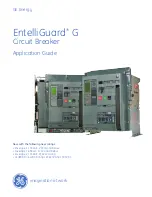
Effective 10/2004
Page 28
I.L. 70C1036H05
4.2.3 INCOM
INCOM programming
(See Appendix D-11)
allows for five
different setting options. These include address (001 –
FFE in hexadecimal form), baud rate (9600 or 1200), and
enabling or disabling external communications trip (EXT
COMM OpenTrip) and external communications close
(EXT COMM CLOSE). The latter two settings will allow or
disallow remote control of the circuit breaker via the
computer.
The fifth setting is the DT 910 COMM mode. When
enabled, the trip unit will adopt the Digitrip 910 communi-
cations protocol. This means that while the trip unit
continues to execute all Digitrip 1150 functionality, the unit
only transmits those messages pertaining to the Digitrip
910 and will be identified as a 910 unit to a communicating
master device.
4.2.3.1 Assemblies Electronic Monitor (AEM II) and Breaker
Interface Monitor (BIM) and BIM II
An Assemblies Electronic Monitor (AEM
II
) can be applied
in the same assembly with the circuit breakers or at a
location remote from the circuit breakers to monitor the
information from any of the Digitrip 1150 Trip Units. The
connections in the network are made by twisted pairs of
wires. The AEM must use the Digitrip 910 communication
setting. Its valid addresses are 001 through 050 decimal.
The Breaker Interface Monitor (BIM
)
can also be used to
monitor the Digitrip 1150 trip unit. However, with BIM must
also use “Digitrip 910” setting of the Digitrip 1150 product.
The above two devices mentioned can receive minimum
communication from the Digitrip 1150 when set in the DT
910 mode and is not recommended for new installations.
The BIM
II
is the preferred monitoring device to be used
with the Digitrip 1150. Its range of acceptable addresses
are 001 through 032 hexadecimal.
4.2.3.2 Remote Master Computer and BIM II
When desired, Digitrip 1150 Trip Units can communicate
with both an Breaker Interface Monitor (BIM
II
) and a
remote master computer (IBM PC compatible with Cutler
Hammer Inc. CONI card or MINT).
(See Figure 4.8)
4.2.3.3 INCOM Network Interconnections
INCOM sends bursts of data on a 92 to 115.2 kHz carrier
at rates up to 9600 baud over twisted pair conductors to
interconnect the many devices comprising the network.
The Digitrip 1150 will light the red LED shown in Figure 1.1
when transmitting on INCOM.
Recommended cable specifications:
•
Cutler-Hammer Inc. cable catalog #IMPCABLE,
Style #2A95705G01
•
Belden 9463 cable family
•
Identical Commscope or Quabbin cables
These bursts of data can be captured and used in a variety
of ways depending upon the manner in which the master
computer software program is written. For example, all the
settings (protection and alarm) can be programmed and
viewed via the master computer. Another example is that
the data for the individual phase current values are avail-
able on the network, but the software must select the
appropriate data, decode it and display it in a useful
manner. Following an over-current trip operation, the
sequence of coded data varies slightly. The cause of trip
and the value and phase (or ground) current responsible for
the trip are available on the network.
4.2.4 Aux ReLaY
The programmable Auxiliary Relays in the Digitrip 1150
consist of Relay A (Alarming and Tripping), Relay B (Block
Close function), and Relay C (Latch relay). If at least one
relay function is enabled, an asterisk will appear beside
the relay letter in the menu. More than one relay function
can be assigned to a physical relay except for the pulse
initiator selection. The selection of Relay A, B or C results
in further selection of three “groups” of settings. Relay A,
when selected, gives the option to enable or disable the
pulse initiator and enable kVAh or kWh settings. When
PULSE INITIATE is ENABLED, all groups for Relay A are
skipped. When DISABLED, Groups 1, 2 may be pro-
grammed and saved for Relay A. Relays B and C do not
have a PULSE INITIATE option and are only programmable
for Groups 1 and 3.
(See Appendix D-15 and Appendix G.)
4.2.5 ALARMS
Alarm programming functions the same way as other
options. Many alarm settings exist. A listing of these
options and their settings can be found in Appendix D-16.
The selection of ALARM TO EventLOG setting will enable
both alarm events as well as trip events to be time-
stamped and placed in the three-position EventLOG.
4.2.6 Digital Relay Accessory Module
A Digital Relay Accessory Module is a separate device
that is programmed via the Digitrip 1150 via ACCBUS
menu. Available module addresses are 1 through 4. Each










































